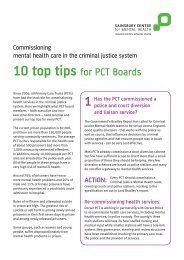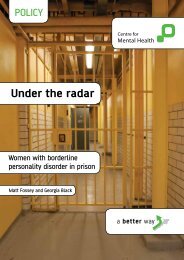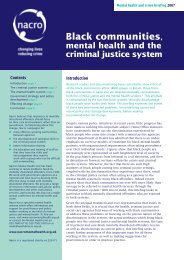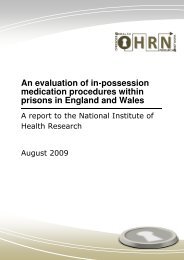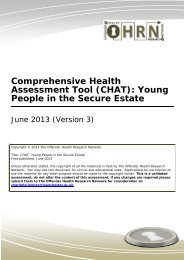Engendering Justice - from Policy to Practice - The Fawcett Society
Engendering Justice - from Policy to Practice - The Fawcett Society
Engendering Justice - from Policy to Practice - The Fawcett Society
- No tags were found...
Create successful ePaper yourself
Turn your PDF publications into a flip-book with our unique Google optimized e-Paper software.
Chapter Five:<strong>Justice</strong> Needs WomenWomen as Workers in the Criminal <strong>Justice</strong> SystemPrison Service…there is a need <strong>to</strong> constantly have <strong>to</strong> prove oneself <strong>to</strong>avoid criticism <strong>from</strong> my male peers who appear very quick<strong>to</strong> judge and very slow <strong>to</strong> forget. 261As the Prison Service has itself acknowledged theresourcing problem in some women’s prisons has resultedin a shortfall in the number of women in uniformed gradesavailable <strong>to</strong> undertake tasks which have <strong>to</strong> be carried outby women staff, including tasks such as full body searching,rub down and pat down searching of women (includingvisi<strong>to</strong>rs) and supervision of showering, bathing andchanging. 262 As one prison worker stated:Where only women are able <strong>to</strong> do the searching onthe female prisoners there should also be some jobstherefore that are specifically assigned <strong>to</strong> men <strong>to</strong> balancethis as at this time women are able <strong>to</strong> do everything andare therefore required <strong>to</strong> whereas it is easier for maleofficers. 263While another officer commented:I don’t think we’ve got enough female staff. Some womenwouldn’t feel comfortable talking <strong>to</strong> a man; some are evenscared of them. I’ve been <strong>to</strong>ld by some women that theydon’t even want them unlocking their cell. 264<strong>The</strong> number of female staff should be increased throughthe use of the genuine occupational qualifications exceptionin relation <strong>to</strong> recruitment, training, promotion or transferunder section 7(2) of the Sex Discrimination Act. Part-timeworking and job-sharing and positive action measures,such as the special measures under CEDAW, would also bevaluable.As Table Seven demonstrates, there is also a lack ofwomen at senior management levels with less than aquarter of prison governors being women. However, itis encouraging that four out of the ten newly appointedDirec<strong>to</strong>rs of Offender Management are female. 265As a recent report noted “government policy on prisons ismired in contradiction.” 266 Staffing levels have increasedbut at a slower pace than the growth in prisoner numbersand meanwhile the budget in real terms has decreased by7 percent since 2001. This is placing real strain on prisonstaff.Sexual Harassment has been a persistent problem withinthe prison service. In 2007, the Equal OpportunitiesCommission (EOC), embarked on a formal investigationof the frequency and persistence of sexual harassmentagainst women and men working for HMPS. However,this investigation has been suspended on the basis ofan agreement between HMPS and the EOC (and now itssuccessor EHRC) on an action plan <strong>to</strong> prevent and dealeffectively with sexual harassment. This agreement lastsuntil 30 November this year, by which time HMPS shouldhave implemented its action plan and put moni<strong>to</strong>ring in<strong>to</strong>place.<strong>The</strong> Commission welcomes the action plan. However,responses <strong>from</strong> females working within prisons reveala culture of institutional sexism. As one prison officercommented, “I feel if I don’t partake in sexual banter I getleft out and am not one of “the boys.” 267 Many responsesalso revealed that women working within the prison servicefeel that this culture is the standard against which they areassessed. As one woman remarked, “You feel that youhave <strong>to</strong> prove yourself a bit more and constantly answerquestions on your capability.” 268I am aware of the measures [equality and diversity] in placeI am also aware of many staff that will not follow thosemeasures for fear of future reprisal. Unfortunately the moreit is highlighted, the less people are honest and decisionsare then made based on how we can make this appear fairand equitable.Female in the prison service, questionnaire response,December 2008Workers also <strong>to</strong>ld the Commission that the prison workinghours make it very difficult for women with children <strong>to</strong>maintain employment. “<strong>The</strong>re should be more familyflexiblehours for women with children. I reckon shifts ofeleven and a half hours are <strong>to</strong>o much.” 269 A number ofrespondents were also concerned that women with caringresponsibilities would be unable <strong>to</strong> fulfil the initial residentialtraining requirements for the prison service. In addition, itwas highlighted <strong>to</strong> the Commission that it was also difficultPage 78







